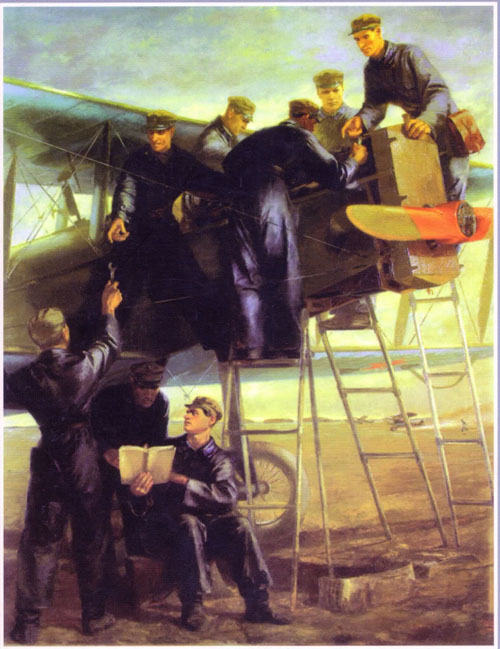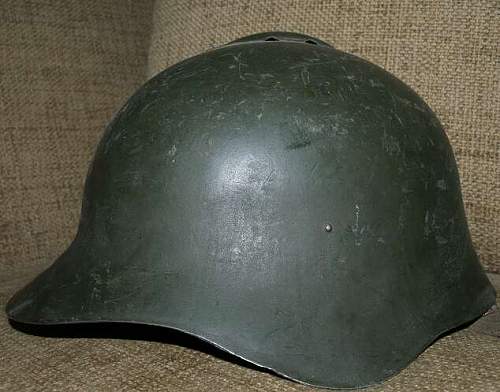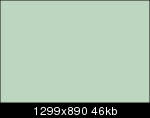
|
by Massimo Tessitori |
|
|
|

Since the late 20s, Soviets started to paint their military planes with a dark greenish khaki paint called Zashchitnyi, that means 'protective' because it makes the plane less visible.
The undersurfaces were painted in a light grey-blue shade; some photos look to suggest the use of silver dope on some early types.
Lacking of color photos, this print of the '30s looks realistic enough to be considered as a source.
| I-1
|
I-1 was a fast plane built by Polikarpov in 1925/26, but it didn't meet favour in pilots due to its high landing speed. Only two prototypes and a dozen of production planes were built, and never put in service. This production plane bears the early livery: olive-green uppersurfaces and light undersurfaces (it's not clear if blue-grey or silver; it's not clear if the fuselage undersurface is light, or green as other fighters); the metallic engine cowling and the wooder propeller are left unpainted. Large red stars were under the wings and probably on their top and on the rudder. |
| I-2 bis
|
The I-2bis of 1929 was painted with the very early livery of very dark gloss green on its uppersurfaces and, probably, on the fuselage undersurfaces, while the wing and tail undersurfaces were probably light, gray-blue or silver. Red stars, although not clearly visible, should be on wings upper and undersurfaces and on fuselage sides. The number 6, probably red with white outline, is traced on the horizontal tail surfaces too, possibly because they were more accessible than the upper wing. |
| I-3 |
The color livery for very early Soviet fighters, as I-3 of 1931, consisted in : all the wood/fabric part of fuselage (including the undersurface) and the uppers of wings and tail surfaces were painted with an extremely dark and gloss color, probably some olive green; the engine cowling was left unpainted aluminium, while the undersurfacves of wings and tail were painted with a glossy light color (difficult to say if it was blue-grey, silver or what else). The stars were with thin black outline and inside circle. |
| I-4
|
The corrugated-metal skinned I-4 of 1931 was painted probably with olive green uppersurfaces and light blue-grey undersurfaces. Being a sesquiplane, the red stars are painted under the upper wing instead of the lower one. |
| I-5,
|
I-5 prototype, 1932 . Silver finish was widely utilized for prototypes and sport planes. |
|
|
These planes appear painted according to different standards: the green of the rear plane, with metal nose, is more glossy and dark of the front plane, that has a black engine cowling. 1935. Photos from Aviakollectia 1/2010, Istrebitel I-5 by V.R. Kotelnikov |
| I-15
|
Photos of I-15 operating in VVS, as this one, are extremely rare and of bad quality; the most of the available photos are of prototypes or of Spanish Chatos. |
| I-16 type 5 |
I-16 type 5 and 6 of 1936 were probably painted with olive green uppersurface and light grey-blue undersurface, with black engine cowling. The red star under the wing has a thin black outline, but not the thin black circle seen on other types. Note the dark, perhaps black, landing gear inside, while bays are of the color of external undersurfaces. The most part of I-16 bears this livery. Remains of a Spanish I-16 Rata show traces of Soviet original blue-grey and olive-green under a layer of light blue and another olive-green probably of Spanish origin.
|
IP-1
|
Grigorovic IP-1 was a ground attack plane armed with two recoilless single-shot guns. About 200 were built in 1932. It looks to bear a standard livery with black cowling. |
| R-1
|
R-1, built in 1922-1932 with over 2,400 built, was a copy of British plane Airco DH-9A. Its uppersurfaces were probably painted with glossy khaki green, while the color of undersurfaces is uncertain (candidates could be clear doped linen as on British planes, or silver, or grey-blue). It's interesting to note the use of painting bort numbers on elevators. |
| R-3PD
|
R-3 was the first all-metal plane built between 1926 and 1929 in 102 examples. These images show bort numbers or national insignas painted on its horizontal tail surfaces. |
| Two photos of R-5 reconaissance planes in the '30s. The planes seem to bear the characteristic livery in khaki-green, probably with blue-grey undersurfaces. Top: The red stars are evident on the first image, that shows also a natural metal nose, and a red rudder with a gull emblem. It's ready to tow a glider at the Central Aero Club. Down: A line of SSS (ground attack version of R-5) in the Kiev military district. Note that the red stars are nearly undistinguishable on the background due to the film, but they interrupt the white stripe on the fuselage sides. White stripes are visible on wing tops too. The fuselage band looks brush-painted silver. Numbers are traced yellow on a profile.
http://en.wikipedia.org/wiki/Polikarpov_R-5
|
|
| TB-1 |
All-metal bombers as TB-1 and TB-3s should have been painted in khaki-green or dark green 3B, with blue-grey undersurfaces. They usually had red stars awith thin black outline and circle. Images from: Aviakollectia 12/2007 on painting of Soviet planes before 1940 by V.I.Kondradiev and V.R. Kotelnikov |
| TB-3 |
All-metal bombers as TB-1 and TB-3s should have been painted in khaki-green or dark green 3B, with blue-grey undersurfaces. They usually had red stars awith thin black outline and circle. |
| TB-3RN |
All-metal bombers as TB-1 and TB-3s should have been painted in khaki-green or dark green 3B, with blue-grey undersurfaces. They usually had red stars awith thin black outline and circle. |
| U-2 in 1930s
|
Photos of U-2 with military marks in '30s are difficult to be found, while the most of them had civilian markings. Anyway,they usually had a military-looking livery, with uppersurfaces painted in khaki green and undersurfaces probably in blue-grey. This plane has unusual white-red marks on its tail, but other red stars on the fuselage and uppersurfaces are not visible. http://en.wikipedia.org/wiki/Polikarpov_Po-2
Below left: Although this plane was photographed in summer 1941 and it seems to have a rough red star hurrily painted on its rudder to comply the standard of that year, the relatively dark shade of its undersurface suggests more the blue-grey utilized up to 1937 instead of the silver of 1937-40 and the AII light blue of 1940-41. The red stars have a thin black outline and are probably reported on wings uppersurfaces too. |
| name of paint | indicative chip | match | typical use | notes |
|
Clear
dope
AI N (1st coat nitro aero lacquer)
|
 |
AKAN 360 (clear doped linen) |
Nitrocellulose
primer for fabric
|
“Unpainted”
exterior fabric surfaces of many planes made in 1920-ies
In 1930-ies AI N dope for AII paints
|
| silver dope |  |
overall surfaces of some R-1 and other planes. Unclear if used on undersurfaces of some types.
|
Early 1920-ies | |
| Grey-blue * |  |
AKAN 371 | Undersurfaces - metal (TB-1, TB-3, R-6) or fabric/wood (R-5, U-2) | 1927-37 |
| “Zashchitnyi”*
olive green |
 |
AKAN 363 | Upper surfaces (metal or fabric/wood skinned), thought to be the standard color | 1927-1937 |
| 3B
dark green |
 |
AKAN 370 | Army paint, sometimes used on metal planes (TB-3) | 1933-37
oil paint |
* “Zashchitnyi” and“Grey-blue” refer to the colours, not to the paint, whose name are unknown.

 |
One of the most important items to identify colors of Soviet planes of '30s is this piece of metal sheet from a TB-3 preserved in Finland; it shows two layer of color: the underlying one is the early Zashchitnyi ('protective' intended as 'low-visibility', that is olive green), the overlying is 3B, a dark green utilized for helmets and vehicles too till 1939, whose use on planes is thought to be occasional (Colour interpretation by A. Akanihin) The second image shows a Soviet prewar helmet SSh-36 painted with 3B color. (from private collection in s. Petersburg) |
 |
An interesting topic about early Soviet colors is here. http://www.terceraescuadrilla.com/foro/index.php?topic=4108.15 There are described shades of paint found on pieces of a Republican I-16. The origin of overlaying shades of olive green and light blue is uncertain, but the underlying light blue is probably an early Soviet blue-gray that has somewhat turned to yellow. |
|
|
|
|
|
See also:
an automatic translation of the booklet : V.I . Kondratyev, W.R. Kotelnikov IDENTIFICATION AND PAINTING of AIRCRAFT of RKKVF and the Red Army Air Force until 1940